
David Bowie obituary
Artist who blazed a trail of musical trends and pop fashion, reinventing himself, his music and media across many decades
Adam Sweeting
Monday 11 January 2016
Until the last, David Bowie, who has died of cancer, was still capable of springing surprises. His latest album, Blackstar, appeared on his 69th birthday on 8 January, and showed that his gift for making dramatic statements as well as challenging, disturbing music had not deserted him.
Throughout the 1970s, Bowie was a trailblazer of musical trends and pop fashion. Having been a late-60s mime and cabaret entertainer, he evolved into a singer-songwriter, and a pioneer of glam-rock, then veered into what he called “plastic soul”, before moving to Berlin to create innovative electronic music.
In subsequent decades his influence became less pervasive, but he remained creatively restless and constantly innovative across a variety of media. His capacity for mixing brilliant changes of sound and image underpinned by a genuine intellectual curiosity is rivalled by few in pop history. Blackstar was proof that this curiosity had not diminished in his later career.
Bowie was born David Robert Jones in Brixton, south London. His mother, Peggy, had met his father, John, after he was demobilised from second world war service in the Royal Fusiliers. John subsequently worked for the Barnardo’s children’s charity. They married in September 1947, eight months after David’s birth, when John’s divorce from his first wife, Hilda, became absolute.
In 1953 the family moved to Bromley, Kent, where David attended Burnt Ash junior school and showed aptitude in singing and playing the recorder. Later, after he failed his 11-plus exam, he went to Bromley technical high school and studied art, music and design. His half-brother, Terry Burns, nearly a decade older than David, introduced him to jazz musicians, such as John Coltrane and Miles Davis, and in 1961 David’s mother bought him a plastic saxophone, introducing him to an instrument that would become a recurring ingredient in his music.
After a 1962 schoolyard punch-up, the pupil in David’s left eye remained permanently dilated, having the serendipitous effect of lending him a vaguely unearthly appearance (the thrower of the punch, George Underwood, remained a close friend and later designed Bowie’s album artwork).
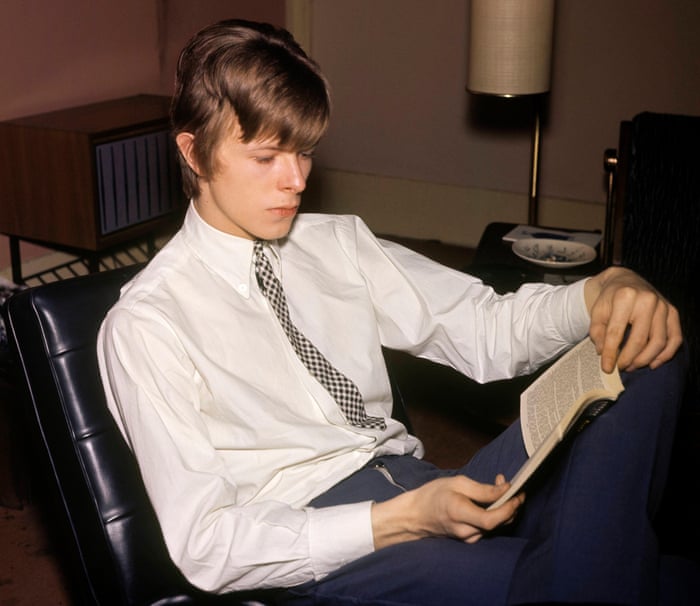
At 15, David formed his first band, the Kon-rads, a primitive rock’n’roll combo that contained a fluctuating number of members, including Underwood. He quickly became disillusioned with his band’s lack of ambition and quit to form a new outfit, the blues-influenced King Bees. They released a single called Liza Jane, but when it disappeared without trace, David jumped ship again and joined the Manish Boys. Named after a Muddy Waters track, they too were blues-orientated. Their single I Pity the Fool proved no more chart-friendly than Liza Jane had done, after which the restless Davy Jones was on the move once more.
His next port of call was the Lower Third, an R&B band from Margate, Kent. The group thought they were auditioning for a singer and equal member, but once they had hired David, they were taken aback when he issued a press statement saying: “This is to inform you of the existence of Davie [sic] Jones and the Lower Third.” Moreover, David, abetted by his new manager Ralph Horton, a former tour manager for the Moody Blues, decreed that the band should be decked out in fashionable mod attire, in emulation of the Who. Fellow members of the Lower Third could not help noticing David’s flamboyant, even effeminate performing style. They released a Jones-penned single, the aptly named You’ve Got a Habit of Leaving, but despite receiving a handful of radio plays, it failed to chart.
It was clear that David’s talents and ambition dictated that he should go solo, and Horton provoked a split with the Lower Third by announcing that there was not enough money to pay their fees. David now adopted the name Bowie to avoid confusion with Davy Jones of the Monkees, and put together a new group via an advertisement in Melody Maker, specifying that he wanted musicians “to accompany a singer”. The new band was named the Buzz.
He dropped Horton after a botched music publishing deal, and in his place hired Ken Pitt, a far more substantial figure who had had success with Mel Tormé and Manfred Mann. Pitt secured an album deal for Bowie with Decca’s Deram label, which resulted in an LP entitled simply David Bowie, released in June 1967. It was preceded by the novelty single The Laughing Gnome, a flop at the time but a top 10 hit when reissued in 1973. Bowie later said of his debut album: “I didn’t know if I was Max Miller or Elvis Presley.” But within its disjointed mix of styles, it found Bowie reflecting on issues such as childhood, sexual ambiguity and the nature of stardom. By the time the album was released, Bowie had already got rid of the Buzz, again citing lack of money.
For a time he studied theatre and mime with the dancer Lindsay Kemp, and in 1969 he started a folk club at the Three Tuns pub in Beckenham, Kent. This developed into the Beckenham Arts Lab, and a variety of future stars, including Peter Frampton, Steve Harley, Rick Wakeman and Bowie’s future producer Tony Visconti, performed there.
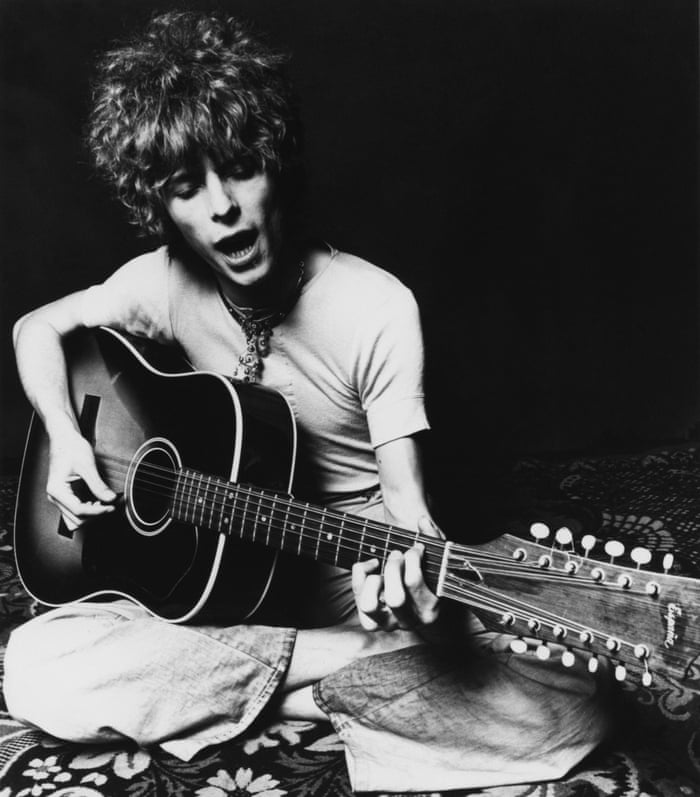
In July 1969 Bowie released Space Oddity, the song that would give him his initial commercial breakthrough. Timed to coincide with the Apollo 11 moon landing, it was a top five UK hit. The accompanying album was originally called Man of Words / Man of Music, but was later reissued as Space Oddity.
The following year was a momentous one for Bowie. His brother Terry was committed to a psychiatric institution (and would kill himself in 1985), and his father died. In March, Bowie married Angela Barnett, an art student. He dumped Pitt and recruited the driven and aggressive Tony DeFries, prompting Pitt to sue successfully for compensation.
Artistically, Bowie was powering ahead. The Man Who Sold the World was released in the US in late 1970 and in the UK the following year under Bowie’s new deal with RCA Victor, and with its daring songwriting and broody, hard-rock sound, it was the first album to do full justice to his writing and performing gifts. The title track remains one of his most atmospheric compositions, and songs such as All the Madmen and The Width of a Circle were formidably inventive and accomplished. The album’s themes included immortality, insanity, murder and mysticism, evidence that Bowie was a songwriter who was thinking way beyond pop’s usual boundaries.
The Man Who Sold the World was significant in other ways too. Its producer, Visconti, became a long-term ally, and in the guitarist Mick Ronson and the drummer Woody Woodmansey, Bowie had found the core of what would become the Spiders from Mars. The UK cover pictured Bowie lounging in a long dress and bearing a striking resemblance to Lauren Bacall, playing on the theme of sexual ambiguity that he would exploit so successfully.
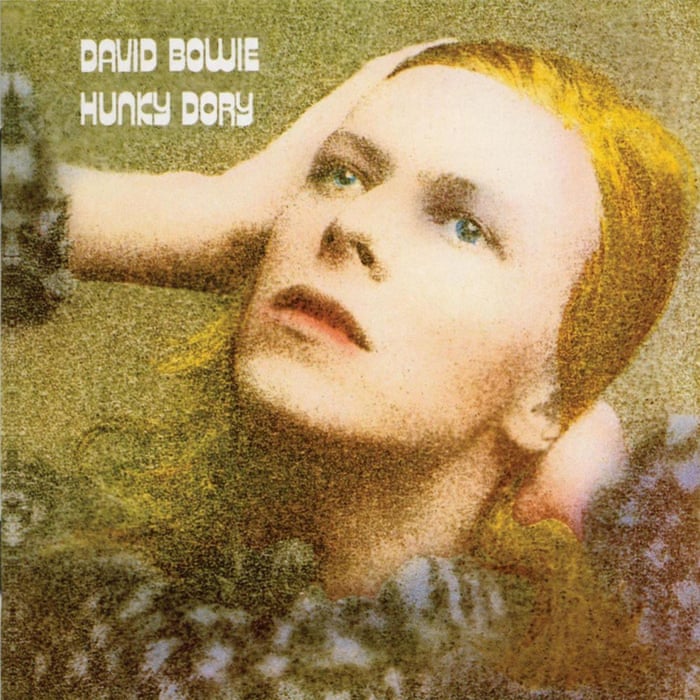
He followed it with Hunky Dory (1972), a mix of wordy, elaborate songwriting (The Bewlay Brothers or Quicksand), crunchy rockers (Queen Bitch) and infectious pop songs (Kooks). It was an excellent collection that met with only moderate success, but that all changed with The Rise and Fall of Ziggy Stardust and the Spiders from Mars later that year.

This time, Bowie emerged as a fully fledged science-fiction character – an intergalactic glam-rock star visiting a doomed planet Earth – and the album effectively wrote the script for his own stardom.
The hit single Starman brought instant success for the album, while Bowie’s ravishing stage costumes and sexually provocative performances (following his carefully timed claim in a Melody Maker interview that he was gay) triggered fan enthusiasm unseen since Beatlemania. Seeing Bowie perform as Ziggy on Top of the Pops was a life-changing experience for a generation of pop listeners in glum 70s Britain.
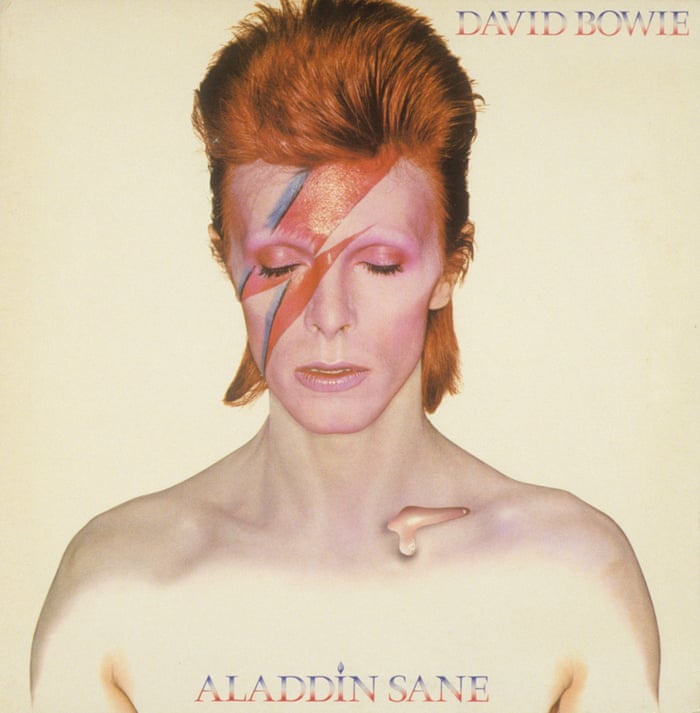
Everything Bowie touched turned to gold, such as his song All the Young Dudes which provided a career-reviving hit for Mott the Hoople, or Lou Reed’s album Transformer, which he co-produced with Ronson. He scored his first UK No 1 album with Aladdin Sane (1973), which generated the hit singles The Jean Genie and Drive-in Saturday. But Bowie was already planning fresh career moves, and in July 1973 he shocked his audience at the Hammersmith Odeon by announcing the retirement of Ziggy Stardust.
He made Pin Ups, a transitional album of cover versions, before embarking on the sinister concept album Diamond Dogs, intended as a musical version of George Orwell’s 1984. Bowie’s commercial instincts remained in fine working order, however, and the album brought further hit singles with the title track and Rebel Rebel.
He took his new music to the US in 1974 with the elaborately theatrical Diamond Dogs tour, which was filmed by the BBC’s Alan Yentob for the documentary Cracked Actor. However, professional pressures and an escalating cocaine habit were making Bowie paranoid and physically emaciated.

Everything Bowie touched turned to gold, such as his song All the Young Dudes which provided a career-reviving hit for Mott the Hoople, or Lou Reed’s album Transformer, which he co-produced with Ronson. He scored his first UK No 1 album with Aladdin Sane (1973), which generated the hit singles The Jean Genie and Drive-in Saturday. But Bowie was already planning fresh career moves, and in July 1973 he shocked his audience at the Hammersmith Odeon by announcing the retirement of Ziggy Stardust.
He made Pin Ups, a transitional album of cover versions, before embarking on the sinister concept album Diamond Dogs, intended as a musical version of George Orwell’s 1984. Bowie’s commercial instincts remained in fine working order, however, and the album brought further hit singles with the title track and Rebel Rebel.
He took his new music to the US in 1974 with the elaborately theatrical Diamond Dogs tour, which was filmed by the BBC’s Alan Yentob for the documentary Cracked Actor. However, professional pressures and an escalating cocaine habit were making Bowie paranoid and physically emaciated.
His increasing interest in funk and soul music came to the fore on the deliciously listenable Young Americans (1975), which gave him a US chart-topper with Fame (featuring John Lennon as a guest vocalist) and earned him a slot on the American TV show Soul Train. This was Bowie’s so-called “plastic soul” album, which he described as “the squashed remains of ethnic music as it survives in the age of Muzak, written and sung by a white limey”.
But once again, Bowie’s frantic creativity was accompanied by crises in his business life. He fired Defries, which spurred long and tortuous litigation and cost Bowie millions, then hired his lawyer, Michael Lippman, as his manager. A year later he went through the sacking-and-lawsuit process all over again with Lippman.
Yet he was still breaking new musical ground. Station to Station (1976), a euphoric dose of what might be called synthetic art-funk, introduced a new persona, the Thin White Duke, which Bowie had carried over from his headlining performance as Thomas Jerome Newton, the melancholy space traveller, in Nicolas Roeg’s film The Man Who Fell to Earth.

But Bowie’s own connection to terra firma was looking increasingly shaky. He told Rolling Stone magazine about his admiration for fascism, and provoked outrage when his wave to the crowd while arriving in an open-topped Mercedes at Victoria station in London was interpreted as Nazi salute.
He found some breathing space by buying a home in Switzerland, where he rediscovered his interest in art and drawing, but by the end of 1976 he had taken up residence in Berlin, where he was accompanied by Iggy Pop – with whom he was working on Iggy’s album, The Idiot – and Brian Eno, who would be the catalyst for another of Bowie’s musical leaps forward.
The upshot was the so-called “triptych” of Low, Heroes (both 1977) and Lodger (1979), where Bowie mixed Krautrock influences with Eno-driven synthesizer mood-music, with at least some pop accessibility for good measure (such as Low’s Sound and Vision or Lodger’s Boys Keep Swinging). Lodger, though recorded in Montreux and New York, used the same personnel as the previous two, with Eno once again acting as creative ringmaster. Meanwhile, Bowie found time to film another leading movie role, appearing as Count Paul von Przygodski in Just a Gigolo (1978).
Bowie’s relationship with his wife had been disintegrating under the pressures of success and the couple’s hedonistic, promiscuous lifestyle, and they would divorce in 1980. This was a year of further creative triumph, bringing a fine album, Scary Monsters (and Super Creeps) and its spin-off chart-topping single, Ashes to Ashes, followed by Bowie’s well-received stint as John Merrick in The Elephant Man on the Broadway stage. To make the accompanying video for Ashes to Ashes, he went to the Blitz club in London and recruited several leading lights from the New Romantic movement, a collection of bands including Visage and Spandau Ballet, who owed much of their inspiration to Bowie.
With hindsight, Ashes to Ashes can be seen as the point where Bowie’s cutting edge began to lose its sharpness, and he was never again quite the cultural pathfinder he had been in his heyday. This process expressed itself in the way he restlessly bounced between collaborators.
He bagged a No 1 single with his 1981 partnership with Queen, Under Pressure, while becoming increasingly involved in crossovers between different media. He appeared in the German movie Christiane F (1981) and wrote music for the soundtrack, and his lead role in the BBC’s production of Bertolt Brecht’s Baal (1982) was accompanied by his five-track EP of songs from the play. He registered another chart hit with Cat People (Putting Out Fire) from Paul Schrader’s movie Cat People (1982).
Bowie continued to make progress as a screen actor with appearances in The Hunger (alongside Catherine Deneuve) and the second world war drama Merry Christmas, Mr Lawrence, both released in 1983. Musically, this was the year in which he marshalled his forces for an all-out commercial onslaught with the album Let’s Dance and follow-up concerts. With co-production from Chic’s Nile Rodgers, Let’s Dance moulded Bowie into a crowd-friendly global rock star, with the album and its singles Let’s Dance, China Girl and Modern Love all becoming huge international hits.
This was the heyday of MTV, and Bowie’s knack for eye-catching videos fuelled this commercial splurge, while the six-month Serious Moonlight tour drew massive crowds. It was to be the most commercially successful period of his career.

Tonight (1984) could not repeat the trick, though it delivered the hit Blue Jean, whose short accompanying film Jazzin’ for Blue Jean earned Bowie a Grammy. But his profile gained another boost from his appearance at the 1985 Live Aid famine relief concert at Wembley stadium, where he was one of the standout performers. In addition, he teamed up with Mick Jagger to record the fundraising single Dancing in the Street, which sped to No 1.
Bowie then returned to the multimedia trail with an appearance in Julien Temple’s shambolic film Absolute Beginners (1986), from which he salvaged some personal kudos by supplying the winsome title song. He also wrote five songs for Jim Henson’s fantasy film Labyrinth, as well as taking the role of Jareth the Goblin King.
In 1987, a solo album, Never Let Me Down, performed reasonably well commercially, but poor reviews were endorsed by Bowie himself (he described it as “an awful album”). The follow-up Glass Spider tour was castigated for its soulless over-production.
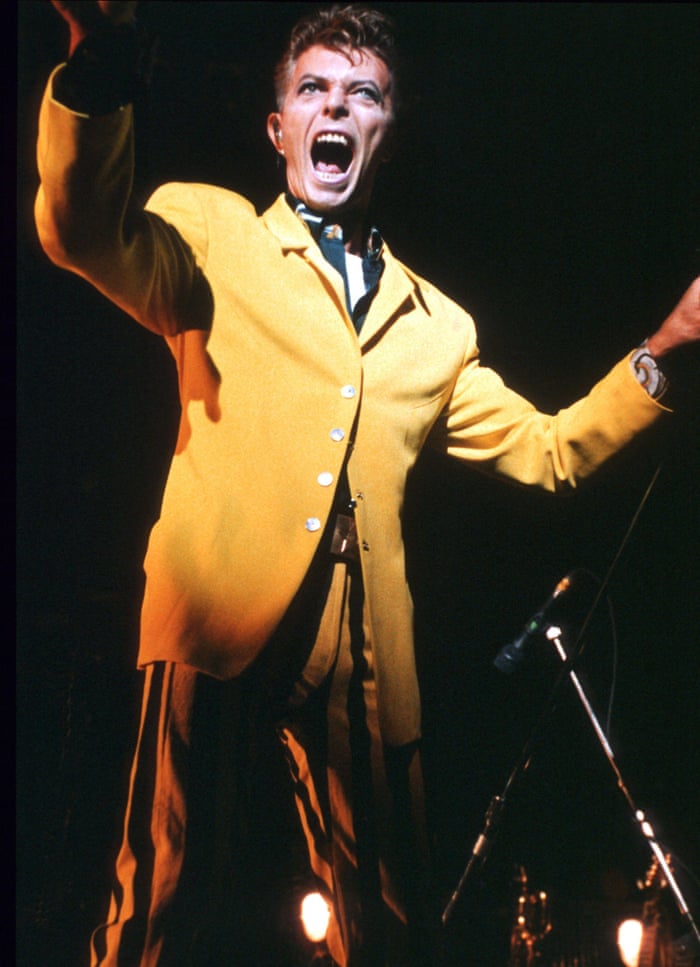
After playing Pontius Pilate in Martin Scorsese’s film The Last Temptation of Christ (1988), Bowie’s next move was the heavy-rock band Tin Machine, with which he sought to appear as a band member rather than as a solo star. Their album Tin Machine (1989) and tour earned a mixture of modest acclaim and howls of outrage. However, by the time they released a second album, Bowie had abandoned the pretence of being “one of the boys” by undertaking 1990’s greatest hits tour Sound + Vision, unashamedly designed to promote the reissue of his back catalogue. Tin Machine dissolved in 1992.
A few days after his appearance at the Freddie Mercury tribute concert at Wembley stadium in April 1992, Bowie married the Somalian model Iman, whom he had met 18 months earlier, and the couple bought a home in New York. This new start in his private life coincided with a search for fresh musical inspiration.
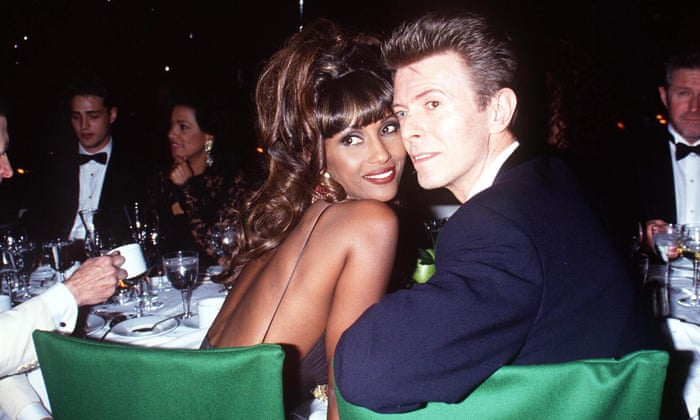
For the album Black Tie White Noise (1993), he reunited with Rodgers and sprinkled elements of soul, electronica and hiphop into the mix. It topped the UK album chart and yielded a top 10 single, Jump They Say.
However, Bowie’s quest for new sounds to plunder began to evince an air of desperation. Outside (1995) found him reunited with Eno and was another commercial success, despite its laborious concept and clumsy adoption of grungy, industrial sounds, while Earthling (1997) borrowed elements of the drum’n’bass style practised by such UK artists as Goldie and Asian Dub Foundation. One of the album tracks was I’m Afraid of Americans, originally written for the movie Showgirls but remade under the auspices of Trent Reznor from Nine Inch Nails. Released as a single, it sat on the US Billboard Hot 100 for four months.
Bowie was demonstrating unexpected forms of creativity in other areas. In 1997 he made history of a sort by launching his Bowie bonds, whereby he netted $55m upfront by surrendering his royalties over the bonds’ 10-year term. In 2000, he delved into online banking with BowieBanc, giving customers an international banking service as well as cheques and debit cards with his picture on them.
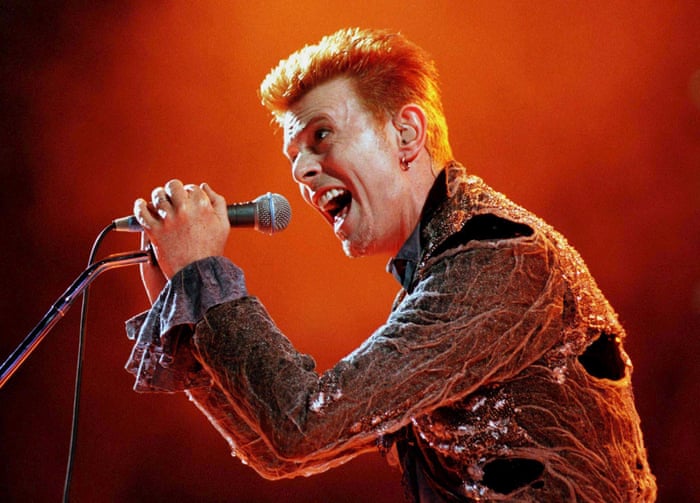
New media and technology influenced his recordings too. His 1999 album Hours… was based around music he had written for a computer game called Omikron, in which Bowie and Iman appeared as characters. Some listeners detected a return to the Hunky Dory days in the album’s reflective, self-analytical musings, though the songs could not match those former glories.
As an adopted New Yorker, Bowie was the opening act at the Concert for New York City in October 2001, where he joined Paul McCartney, Jon Bon Jovi, Billy Joel, the Who and Elton John in a benefit show six weeks after the 9/11 attacks. Bowie sang Paul Simon’s song America and his own Heroes.
He played himself in Ben Stiller’s fashion industry spoof Zoolander (2001). The following year, he was artistic director of the Meltdown festival on the South Bank in London, opening the event by performing the first concert of his own Heathen tour, in support of his album of the same name. The work reunited Bowie with Visconti for the first time since Scary Monsters, and sold 2m copies worldwide. It was nominated for the annual Mercury prize.
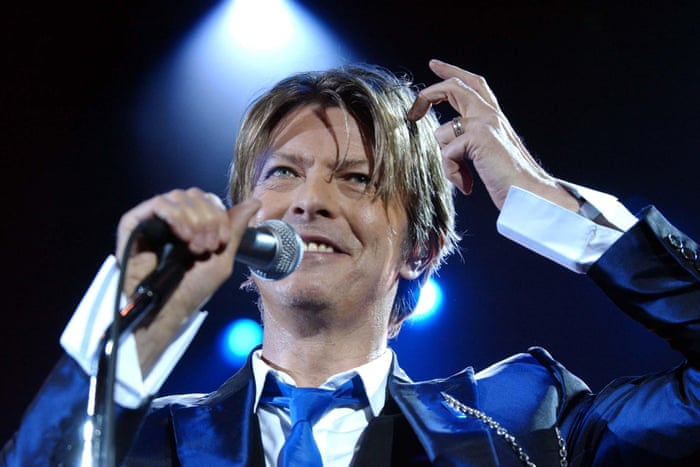
A re-energised Bowie was back in the studio with Visconti the following year for Reality, another successful outing welcomed for its energy and musical freshness. However, in the midst of his Reality tour in 2004, Bowie was stricken with chest pains while performing at the Hurricane festival in Germany and underwent an emergency angioplasty procedure in Hamburg to clear a blocked artery.
He took the medical emergency as a warning and reduced the pace of his activities. He made a handful of guest appearances, including a couple of live shows with the Canadian band Arcade Fire, then in 2006 announced he would be taking a year off from touring and recording.
Despite this, shortly afterwards he appeared with Pink Floyd’s David Gilmour at the Royal Albert Hall, singing the Floyd classics Arnold Layne and Comfortably Numb. In February that year he was given a Grammy lifetime achievement award, having been inducted into the Rock and Roll Hall of Fame in 1996. In The Prestige (2006), Christopher Nolan’s film about two battling magicians, Bowie featured as the inventor Nikola Tesla. Nolan said he cast Bowie because he wanted somebody “extraordinarily charismatic”.
In 2007 Bowie was curator of the eclectic High Line festival in New York, and included among his choices Arcade Fire, Laurie Anderson and the comedian Ricky Gervais. In 2008 he contributed vocals to a couple of tracks on Scarlett Johansson’s album of Tom Waits cover versions, Anywhere I Lay My Head.
In 2010, a live double CD, A Reality Tour, was released on Bowie’s own ISO Records. Recorded in Dublin in 2003, it was a survey of most of the key moments in his musical career. Reviewers were enthusiastic, but could not help noticing the valedictory feel of the album. “Nobody really knows if Bowie is hanging up the spacesuit for good,” said Rolling Stone. “But if so, this is one hell of an exit.”

But there was more to come. In 2011 he released the album Toy, which dated back to 2001 and comprised tracks from Heathen and their B sides plus versions of older material. Of far greater significance was The Next Day (2013), his first album of new material in a decade. Produced by Visconti, it was preceded by the single Where Are We Now?, which gave him his first UK top 10 hit since 1993. The album topped charts in Britain and around the world, reaching No 2 in the US. In 2014 Bowie was given the Brit Award for Best British Male, making him the oldest British recipient in the awards’ history.
He is survived by Iman, their daughter, Lexi, his stepdaughter, Zulekha, and his son, Duncan (formerly known as Zowie, then Joe), from his first marriage.
• David Bowie (David Robert Jones), singer, songwriter and actor, born 8 January 1947; died 10 January 2016









No comments:
Post a Comment